Relative kinematics of a passing moment
- November 6, 2014 – January 10, 2015
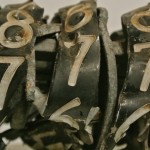


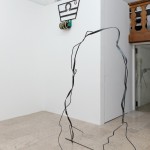
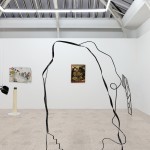
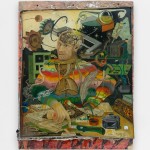
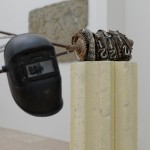



- Welcome to Planet Kafchin!
by Géza Dabóczi
- For once I am obliged to ask an absurd question: apart from the Apollo mission astronauts, has anyone already stepped on the ground of a star other than ours?
- No? In this case, dear terrestrial pithecs, prisoners of this ozone bubble, don’t miss this opportunity! Here we have a promotional offer; instead of incredibly expensive celestial excursions being proposed by our competitors at Baikonur, reserve yourself a one-way cortical space odyssey—sensation of weightlessness guaranteed! Destination: the cortical planet Kafchin. And this is no trip for the fainthearted! To date, of course, no guide has been published. And we are not in a position to offer you the poly-morpho-theistic preparatory course which would be a must before leaving. And don’t count on a guarantee of ergo-cervical first aid either. To those who might not have mental health insurance, we recommend avoiding climbing up to the gallery deck—what am I saying: let us not hesitate to bedeck the ticket office with a no entry sign sporting the icon referring to homo sapiens mercantilus lucidus vulgaris.
- Theoretical physics may well fill with abstruse hieroglyphs oceans of paper about the possible existence of parallel universes, people, from the chairs of Babel-like academies, may well spread like chatterboxes over the multiverses, people may well organize auto-boxes for atomic nuclei in particle accelerators costing billions, and, in Frankenstein-like laboratory-caves, force cellular nuclei to couple or split, but, to date, we have still found no other reality, and we are still struggling to unearth a nice extraterrestrial vertebrate god.
- So here is something that will put an end to the quarrel between parallel worlds, and from now one we will also be able to dispense with hybridizing to right and left in the hope of obtaining a meta-biological creature, and even saving on the costs of interplanetary transport! All we have to do is go and see a Mihut Boşcu exhibition. This is where, before our very eyes, the secret maps of the labyrinthine meanders of the cervical planet Kafchin will be revealed. His post cards will bombard you with infra-cervical equations, while his pre-atomic and post-cerebral pedagogic installations offer us—we pitiful one-dimensional puero-pithecs—a one-off opportunity to glimpse the daily round on this one-of-a-kind planet.
- As for all the creatures, entities, events and phenomena which are produced on it, a close scrutiny of them to discover and organize pre-minerals, post-animals, proto-mythics and anthropo-unreals in categorical classifications is a task which goes way beyond my meagre capacities as a one-dimensional tube worm. Earth is involved in a process of self-healing spanning several million years; this process foresees the future appearance of a homo post-sapiens, genetically mutant, with a spiraled encephalon and a holistic consciousness, who will be capable of writing the encyclopaedia of the Kafchin galaxy. Unfortunately, this will not happen tomorrow. When we look at present-day humanity tearing itself apart like in a zoo cage, moved by viscera which it takes for ideals, we would be less surprised by the re-appearance of the Megalosaurus than by the advent of that so eagerly awaited generic avatar.
- For me it is no less of an enigma knowing how Boşcu discovered the “Kafchin maps”, and how it is that he has been capable of noting this neuro-Kafchinian experience in a format prior to the computer age? In comparison, retracing the origin of the map of Piri Reis is a riddle for retarded children. These visual notices are the uncensored version of the diagnosis of a galactic psycho-transformation: a neuron hunt in the bush of the Delta of Consciousness and encephalo-domestication in the amniotic fluid of the Milky Way. It is part of sidereal dice that is being revealed before our eyes, a Sisyphean peeling of the ego, myriad rococo fantasies for electro-cervical comic strips. These isomorphic schizotopes which he jettisons in the midst of consensual hallucinations. These retinal soap operas of indeterminate duration. Our questions grow in number until they form the ant-hill of our perplexity: might that be an Adam in the process of constructing a robotic alter ago in a bunker? Dairymaids milking grey matter connected to a cosmic roulette worked by a Titan-hearted homunculus? An invasion of nano-particled fleas?
- A flow of rainbow consciousness rolling its waves through a crack in time? The cogs of a cosmogonic moment? A self-portrait compressed in the vice of Chronos in the middle of a tarot game? We can recognize all this here, but nothing of all this is enough—something quite different is involved: a world with a fathomless plurality of meanings. A legion of homunculi clearing with hatchets the scrub of a neuronal forest, mental geometry of a crystal ball soothsayer, a self-robotized neuro-hermit, the strings of time and their spirals deeply buried in the catacombs of consciousness, cosmo-parasites of the neutronal yelping clinging to the fullness of spectral and undulatory functions, inhabitants of space-time wormholes, clandestine weddings of electrons and positrons slap bang in the middle of the luxuriant jungle of a DNA sequence, or a white-bearded Creator having fun blowing cosmic dust in our faces and slowly licking neuronal connections, etc., etc. …, in a word: proto-bio- and post-electro phantasmagoria in industrial quantities.
- Hey! Hardly have I glanced at one or two post cards, and here I am speaking in transhumant tongues…
- His installation in the form of a zodiacal snake is the magic instrument of a chrono-demiurge trying to slip through the illusions of understanding. Is the gift of sight an arcanum of personal alchemy, or does it depend on the astro-translogic of a space-time serpent? On this planet, the categorical code is an unknown mode. What Boşcu paints for us is a travel journal in the land of Erebos, taken from a point of neuro-galactic eschatology that is out of competition, without depriving itself of carrying out, as a bonus, minor works of mental sewer draining, with the dark and mischievous wit—so refreshing—that is his hallmark. Beneath the exo-crust of the planet Kafchin is hidden a reversed camera obscura, a generator of images, whose machine never stops. This inexhaustible projector, in the framework of a process of self-healing, covers the outer crust with a balm of colours, softens the meanders of the projection screen, while harassing with visionary inductions an external world plunged in the contemplation of a rugged heliograph.
- Quite recently, in the thick of the modernist craziness, Emil Cioran launched his ultimatum: “Give me another world, or I’ll suffocate!” Well, Mihut Boşcu, for his part, does not make a rumpus and does not whine: he nibbles the handle of his brush a bit, and makes one for himself. As a young candidate with the dignity of a surrealist-postmodern magus, he does not concern himself with manipulating world-matter, exclusively exploiting the mine of his own mind. Before our eyes he spreads out the secret maps of his cerebro-flood plain as if they were (if, at least, we are to believe the unofficial testimony of the aforementioned Boşcu) just the dreams of a mystical bio-root with a soft spot for self-mockery. This, here, is a world without borders and without conventions. Boşcu is the explorer of shapeless and primordial neuro-mirages. This notorious compulsive liar is a tamer of minds. A “mutant” soaked-through and possessed, painter of a neuro-galactic eschatology.
- Wandering among the meanders of the neo-cortex, he looks for Ariadne’s thread. Like so many other artists, he too set out vowing to behead this monster who has pride of place in the very middle of the labyrinth of a cerebral fossil, defecating visual matter there without interruption. But what will come to pass if he ends up being successful? What will he do if, in the twilight of all death throes, he finds himself looking into a large glazed mirror?
- Meanwhile, let us allow him, in his own sweet way, to pursue his quest for the lost thread—neuro-Ariadne’s thread.
- Géza Dabóczi
- (Translated by Simon Pleasance from a French translation of the original Hungarian text translated by Raoul Weiss)









